As an exiled Geordie myself I have got close family ties that served in this regiment and I myself belong to the DLI Territorials.
As you will see background is very important to me:
The DLI served with distinction in North Africa and amongst it's battle honours are Gazala, Gabr el Fakri, Mersa Matruh, El Alamein, Mareth; Landing in Sicily, Solarino, Primosole Bridge and Sicily.
General Montgomery selected the veteran DLI to be one of the assault battalions to land on Gold Beach on D-Day and whereas other veteran divisions came in for criticism the 50th Tyne Tees performed admirably, overcoming all difficulties advancing to the outskirts of Bayeaux by the end of the day, no other division came closer to claiming all it's objectives.
As the DLI pushed inland they found they faced elements of the 12 (Hitlerjugen) Waffen SS and also the elite Wehrmacht unit, The Panzer Lehr Division.
Colonel H. Woods, Commanding Officer of the 9th. Bn. Durham Light Infantry {151 Bde, 50th.Division} was ordered to take and hold the village of Lingevres by the 14th. June. This would in effect cut the German front line in half and out flank Tilly-Sur-Suelles. On the 13th. he sent a fighting patrol forward to locate and discover the disposition and strength of the enemy holding the village.
'B' Company was sent with elements of the 4/7th. RDG's{ 8th. Independent armoured Bde.} in support. The patrol ran smack into a well defended German position in the woods to the north of Lingevres. Two of the 4/7th.RDG's Shermans were 'Brewed Up' and 'B' Coy suffered terrible casualties including 3 officers killed, the Company Commander {Major Kenny} being wounded . This area was defended by Panzer Grenadiers with close support from Tanks and mortars.
At the same time as the attack on Lingevres was taking place, the 6th.Bn. Durham Light Infantry with the support of B Sqn. 4/7th. RDG. Who would be attacking the neighbouring village of Verrieres. {situated to the north west of Lingevres}. The 9th.Bn. DLI would be supported by 'A' Sqn. 4/7th. RDG. They would have the support of all the Divisional Artillery and support by a fighter squadron of Typhoons, from the air. The infantry would advance behind a creeping barrage, supported by the tanks, and firstly capture the heavily defended woods, then take the village. That was the basic plan. However Colonel Woods had not been given enough time to properly patrol his intended objective and therefore did not fully appreciate the depth and positions of the opposing unit.
Firstly the Artillery and planes gave the woods a good pounding. The typhoons dropping two bombs and firing there 10 rockets into the area. Then Durhams crossed the start line into a large cornfield, at the other end of which was the German held woods. It was a two company attack, 'A' Coy. on the left, 'C' Coy. on the right. Three DLI Bren Gun Carriers were to the right rear of 'A' Coy.
They were supported by the Shermans of 'A' Sqn:
Tank 1 'A' Sqn Commander's tank. 75mm Gun
Commander Major Jackie D'Avigdor-Goldsmid
Tank 2 'A' Sqn. 2nd.In Command. 75mm Gun.
Commander Capt. John Stirling.
Tank 3 4th Troop Commander. 75mm Gun.
Commander. Lt. Alastair Morrison.
Tank 4 Sherman 'FIREFLY'. 4th.Troop 17 Pounder Gun.
Commander. Sgt. W.Harris.
Tank 5 Sherman. 4th.Troop. 75mm Gun.
Commander. Cpl. Johnson.
Tank 6 86th.Field Regt. R.A Command/FOO* Sherman Tank. No Gun.
Commander. Major Kenneth Swann {* Forward Observation Officer.}
All of these Tanks entered the Cornfield and began to advance towards the German held woods. For around 7 to 8 minutes nothing happened, the barrage began to move beyond the woods and land on the village behind. All of a sudden a German tank fired from the woods and 'brewed up' a Sherman {tank/crew unknown}. A second tank fired from the other side of the wood and then a deadly hail of small arms fire swept the forward rifle companies of the Durhams. Men were falling all around and most of the officers in 'A' & 'C' Coy. became causalities within minutes [Major Charles D'Arcy-Irvine having been wounded in the head, his CSM wounded in the legs and abdomen]. Lt.Williams ran to tell Colonel Woods that 'A' Companies C.O. had been wounded, when he himself was wounded by several bullets in the legs, he was carried out of the fire zone and to safety by his Sgt., Charles Eagles, who then returned to the battle. Soon afterwards Colonel Woods contacted his 2 I/C on the wireless and ordered him to advance with his company on the village. Colonel Woods would try and extract his men from there current position in the German held woods and make his way into the village to join Major Mogg [2 I/C]. Within minutes of this Colonel H. Woods was fatally wounded by a mortar round. Feet away was Sgt. Charles Eagles, who said that Woods last words were " Surely they haven't hit me?" before dying.
Major John Mogg now found himself in command of the 9th.Bn.Durham Light Infantry. Mogg ordered 'C' & 'D' companies, on the right, to press on with the attack in the direction of the village. They would have the support of 'A' Sqn. 4/7th.RDG's. Lt.A. Morrison, 4/7th.RDG, was ordered, by Major d'Avigord-Goldsmid, to advance on the village with his 4th Troop, to assist the Durhams. He could see the Durhams advancing down a lane into the village. Morrison's tank lead the way with Cpl Johnson's and then Sgt Harris's 'Firefly', behind. The Durhams and Dragoons pressed on and fought there way onto their objective, the Village of Lingevres. The German defenders were determined to hold on to this key position and fought for every yard. Sniping was a particular problem facing the DLI, but a burst from a tank's Browning or a few rounds from one of there guns soon sorted out these hold ups. What remained of the Durhams and the 4/7th. RDG's now found themselves in charge of the village, which they would have to defend against any German counter attacks. Lt.Morrison advanced with his tanks to the area of the war memorial, next to the church. German artillery were now ranging onto the village. Lt. Morrison placed Sgt. Harris's 'Firefly' facing the approach from the direction of Tilly, Cpl. Johnsons tank was defending the road to Verrieres [which was under attack by 6DLI & 'B' Sqn.4/7th.RDG] and Lt. Morrison's tank faced in the direction and covering the roads to Longraye & Balleroy, by the war memorial.
Sergeant Harris spotted a Panther moving in the distance which was promptly knocked out with the 17pdr fired by his gunner Trooper MacKillop.
A bit later, after two of the Durhams 6pdr anti-tank guns had been knocked out, Sergeant Harris, who was covering the Lingeveres - Tilly road to the East, spotted a Sherman driving up the road from Tilly fast towards him. Just before reaching the village the Sherman quickly drove off up a side road, revealing a Panther just behind it. However Harris and MacKillop were quick, and disabled the Panther with one shot, knocking off a track and causing it swerve into a hedge. The Panther was brewed up a bit later by a PIAT team commanded by the Durhams CO Major John Mogg, who was actually the bloke who pulled the trigger on the PIAT!!! Talk about leading from the front.
Shortly after that, tanks were heard to the south, and Corporal Johnson's tank went forward to investigate. However it was hit just infront of Lingeveres church and disabled without brewing. Johnson climbed out suffering from wounds from which he would die the following day. The radio-operator, L/Cpl Draper jumped out of the Sherman and ran for cover, but realised that the driver, Trooper Dagley was trapped inside (in the Sherman, if the turret was turned in a particular direction, the driver's hatch would be blocked!!!), so he ran back (in full view of the enemy) and helped him out by jumping back in the tank, traversing the turret, then climbing round and pulling him out of the hatch. But sadly Dagley died a few minutes later.
The rest of the afternoon, the enemy mounted several attempts to recapture the village, but all were beaten off. But tanks were running short of ammunition, and had to go to the rear to resupply. Harris went first, and was back in Lingeveres just in time for the final actions of the day.
4 Panthers were moving East towards Lingeveres. The rearmost tank was knocked out by Captain Stirling, A Squadron's second in command, who was to the north-west of the town covering the flanks. The other three, seeing this, sped right towards the town. Harris was by now north-west of the church, in a perfect position to take on this new attack and promptly knocked out the leading Panther, and then the Panther 50 yards behind it. The last Panther carried on past the wrecks right into Lingeveres town centre, where it too was disabled by Harris and MacKillop.
This final action marked the end of the days fighting, and the Germans made no further serious attempts to re-take Lingeveres. Harris was awarded a DMC and MacKillop got a Mention in Despatches for destroying 5 Panthers with as many shots!!!
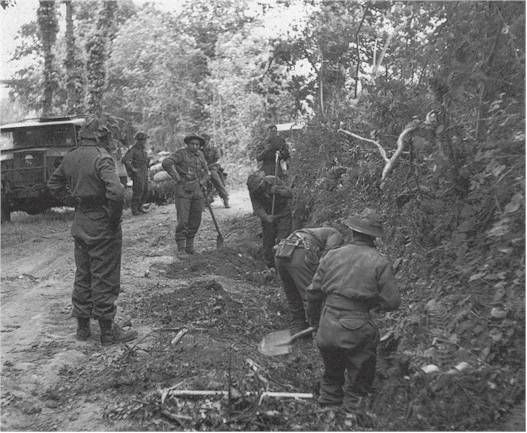
9DLI dig in near Lingevres

9DLI anti-tank gun at Lingevres
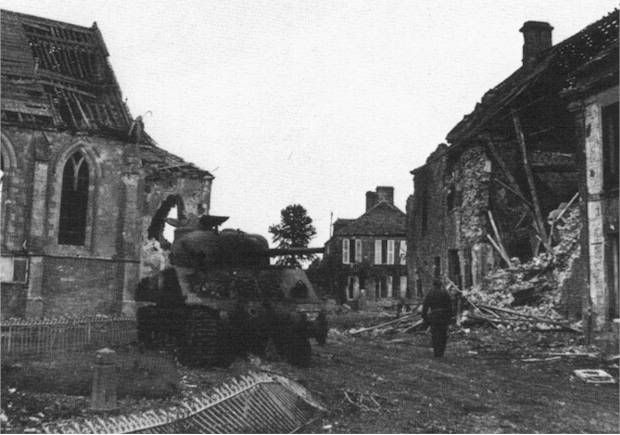
cpl Johnson and trooper Digley's Sherman
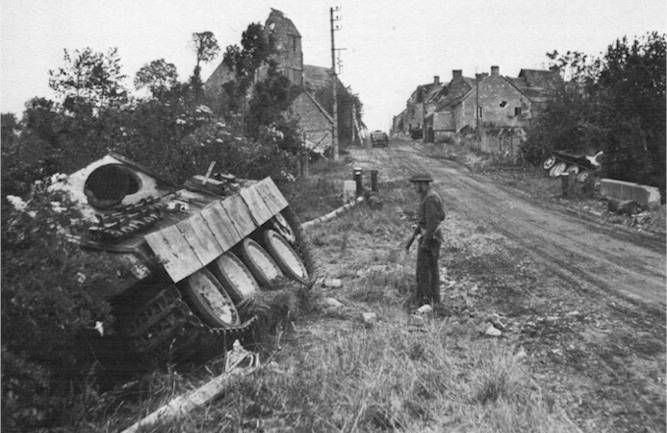
2 knocked out Panthers
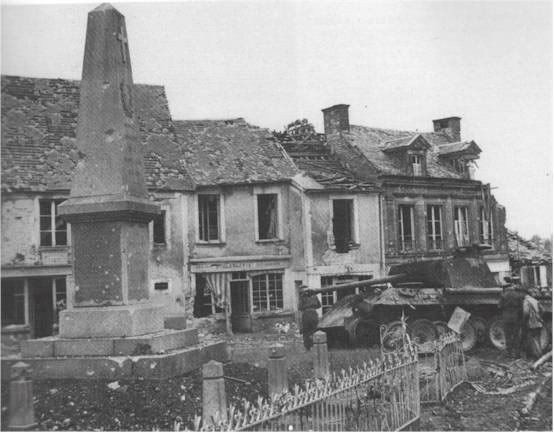
knocked out Panther by the war memorial
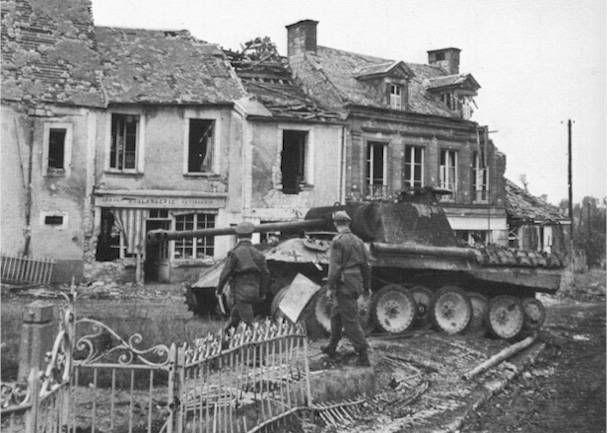
knocked out Panther no.225
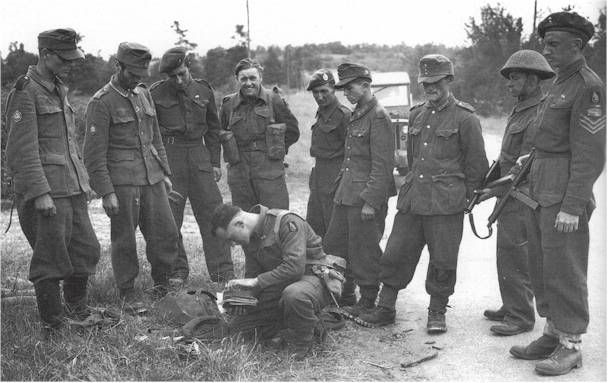
Lehr Pow's
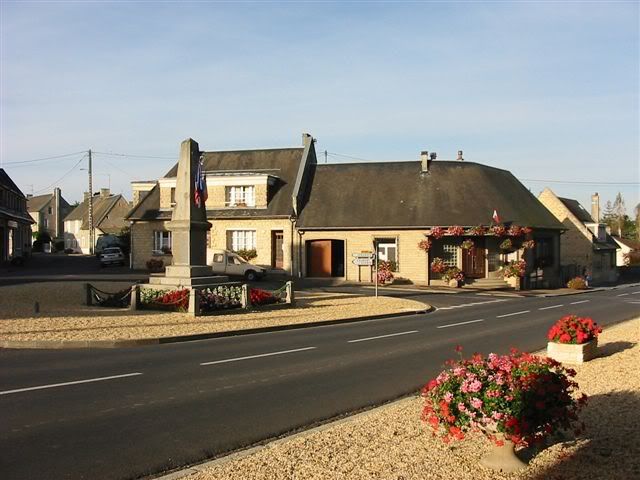
Lingevres today
Well that's the background to my project now onto my models:
First up 'A' Coy command:

Do you know where exactly the 6pdr was positioned in the town?
ReplyDelete